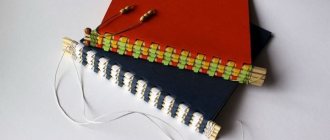| How to replace a hole punch | Description |
| Shilom | At home, many people use an awl instead of a hole punch. They can easily pierce a sheet of paper, but more often such a tool is needed for working with plastic. To make it easier to pierce the sheet, it is better to preheat the awl on a gas burner. You can also use a regular lighter. |
| Soldering iron | A soldering iron can also replace a hole punch only in certain cases. They can easily make a hole in a sheet of plastic. In this case, it is important to carefully monitor how hot the soldering iron is; if you are careless, you can make a large hole and get burned. |
| With a nail | You can make a hole of the required size in paper or other thin material with a regular nail. When working with plastic, it must be preheated. |
| With a small screwdriver | Such a tool is useful only if a hole needs to be made in plastic. |
A hole punch is a mechanical device that is designed to quickly punch holes in paper. There are tools that can be used to work with denser materials. Manufacturers offer hole punchers that can make one or four holes at a time.
In some cases, you don’t have the right tool at hand and you should know what you can use to replace the hole punch.
DIY metal hole puncher
Hello to all DIY lovers.
In this article I will tell you how to make a metal hole punch with your own hands, which will be useful in creating holes in sheet metal, as well as other materials. The assembly of this homemade product does not require any hard-to-find parts; car parts are sufficient.
Before you start reading the article, I suggest watching a video that shows in detail the assembly process and testing of a homemade tool.
In order to make a hole punch for metal with your own hands, you will need:
* Automotive tie rod * Valve * Cuttings from turning cutters * Disc cutter * Metal lathe * Welding machine * Welding mask, gauntlets * Hammer * Metal plate 2 mm thick * Two M6 bolts * Spring, washer * Gloves, safety glasses, headphones * Angle grinder, cutting disc
Step one.
We install the disk cutter into the three-jaw chuck of a metal lathe using a special mandrel; if you have a milling machine, you can make a groove on it.
You also need to cut a 2 mm thick plate from sheet metal, and then drill two holes in them with a 6 mm drill.
Step five.
It's time for welding work. We weld two cuts of the cutter to the steering rod with a small gap relative to each other, and one should be about 15 mm longer than the other.
When working with a welding machine, be careful and use a welding helmet and gloves.
This hole punch is useful when working with sheet materials in which you need to quickly and evenly make holes of the same diameter. In this case, the diameter of the holes made using a homemade hole punch is 6 mm; if necessary, this parameter can be changed by making a rod of the required diameter.
That's all for me, thank you all for your attention and creative success.
Hole punches - what is the difference from a countersink?
A countersink is a multi-blade cutting tool that is used to machine cylindrical and conical holes in parts. The purpose of this work is to increase the diameter, improve not only the surface quality, but also the accuracy of the hole dimensions. Any actions performed by this tool are called countersinking, or rather, it is semi-clean processing of a hole by cutting off small defects. A countersink punch is a tool that combines two functions at once. The sharp tip allows you to immediately punch holes, and the built-in blades expand them to the desired diameter .
The countersinking process is a precision machining operation that requires high power. Often such work can only be performed using special machines. Drilling machines of all types are suitable for this (these are the most common jobs), turning machines, boring machines (as secondary operations), milling machines (both horizontal and vertical, but they are rarely used, only as one part of the program), modular machines (this may be one of the operations in the automatic line).
A standard tool consists of a cutting part, working and calibrating parts, a neck and a shank. The cutting part is made in such a way that the main cutting edges are located on it. They are always located at a certain angle. The size of the angle depends on the purpose and type of countersink punch. Typically, if they are used for ductile metals, the angle should be about 15 degrees, and if for brittle metals - about 5 degrees.
Manual Hole Punch for Sheet Metal
This publication presents three tool options for punching holes in sheet metal . If you want to find out what exact templates and drawings to make a hole punch for your workshop, then watch the video of the “Garage 91 Gomel” channel at the very end of the article.
Another master, Ilya Konakov, made a video on his channel about how to make a hand-held hole punch that can easily handle sheet metal. The idea arose during the work on replacing the bottom on the nine. Those who do body repair know what it means to drill a lot of holes.
Everything is welded through the holes. In order not to do this with a screwdriver or drill, the master decided to improve the technology. The firmware took approximately 3 hours. Available materials were used. The video shows the entire mechanism and what it is made of. How to work with sheet metal. The force is small, although it is advisable to press the hole punch with both hands. The holes are 7 millimeters.
Pneumatic edge bender
Particularly popular among craftsmen are edge benders with pneumatic drive, which work as a “rotary beam”. The pneumatic drive contributes to significant pressure (up to 6.2 bar) on the workpiece. But such equipment can be used when working with sheet metal no thicker than 1.2 mm. In this case, the edge width will be no more than 12 mm.
If you want to make a pneumatic machine with your own hands, you must take into account that its operation requires an air flow of at least 113 l/min.
Pneumatic punch
This is a universal tool model. On one side, the structure is equipped with a mechanism for punching holes, on the other, with jaws for forming an edge.
Thanks to this, you can simultaneously bend the edge and make holes in the metal for fasteners. That is why the tool is often called a pneumatic punch. Its working part is made of high-speed steel. The rubberized handles of the product are equipped with springs. They help reduce pressure on the palm, which facilitates the process of punching and processing.
Any model of hole punch-edge bender works much faster and more efficiently than its manual counterparts, which is why it is intensively used at service stations and car repair shops.
Manual hole punch for metal: do it yourself and save money
All those who are involved in metalworking work with sheet metal know how important it is to competently and accurately make holes in sheet metal. The quality of the final work directly depends on how accurately these holes are made. Of course, nowadays there are a lot of different devices capable of making high-quality holes in fairly thick metal, but they are all expensive. It’s obvious that we want to save on such a purchase, but is this possible?
This article will talk about how to make a high-quality and effective hole punch with your own hands . Let's get started!
All the necessary items for this project are shown in the photo below. As you can see, we need:
- Two metal parts fastened together using fasteners
- Spring
- Sharp tip
Ordinary metal rods or handles from metal scissors can also act as metal handles. The main thing is that our homemade product creates enough leverage to pierce a sheet of metal.
In order for our tool to acquire the desired functionality, it is necessary to equip it with a special durable tip . The easiest way to make a tip for our device is to grind it out of a metal drill. Such drills are usually made of very durable and high-quality steel with good technical and operational properties. Our homemade product needs similar characteristics if we plan to use it often.
Below is an example of our homemade product in action. For additional comfort, you can equip the device with a return mechanism (a regular spring). This is necessary so that you do not have to return the tool to its original position each time.
Areas of application
Metal bending devices are used in various industries. They are used to create folds from roofing iron, make rectangular air ducts from tin or metal sheets, prepare the edges of products for welding, and parts of geometric shapes. Manual edge benders are actively used for construction and repair work. They are in demand during car repairs.
Among the advantages of this technology, in addition to the small thickness of the resulting edges and the low cost of rolled metal, one should add high resistance to wear.
How to make a paper hole punch with your own hands
To make it easier to pierce the sheet, it is better to preheat the awl on a gas burner. You can also use a regular lighter.
In this case, it is important to carefully monitor how hot the soldering iron is; if you are careless, you can make a large hole and get burned.
A hole punch is a mechanical device that is designed to quickly punch holes in paper. There are tools that can be used to work with denser materials. Manufacturers offer hole punchers that can make one or four holes at a time.
In some cases, you don’t have the right tool at hand and you should know what you can use to replace the hole punch.
To make neat holes in the paper or card through which the sheet will later be fixed, you can use an awl. Such tools can be of different diameters; you can experiment if you don’t have a hole punch at hand.
An awl can also be used to make holes in thin plastic. It is better to warm up the rod first, this will make the work much easier. During the process, do not forget about safety rules so as not to get injured.
Tags
at hand not at hand. at hand. with your own hands Handicraft techniques with a broken handle you can old handles. cut off handles. with your own hands for real needlework you can make a hole you can make a hole Make a hole to make neat easy to do too you can do it without free time yourself with your own hands Add your homemade metal with your own hands metal with your own hands made with your own hands. do-it-yourself parts do-it-yourself parts do-it-yourself traction rods do-it-yourself springs
with a drill at home, cut out comments, share, you can make photos here, make special edges
Alternative options
There are also more labor-intensive processes that few people want to work with.
- Beautiful holes in a homemade postcard can be made with a brass tube, well sharpened, on one side. To make everything look original, you should choose a tube with a square cross-section. In this case, you need to place a soft board under the postcard, and gently tap the tube with a hammer until a hole is created.
- Instead of a hole punch, holes can be made with a scalpel or even a stationery knife. The work is quite painstaking, but the result will be the same as originally wanted. You can get a shaped hole by cutting it out with 2 screwdrivers.
At home, you can easily find something to replace a hole punch with. It all depends on the availability of free time and the tools that are at hand.
Hello to all DIY lovers. In this article I will tell you how to make a metal hole punch with your own hands, which will be useful in creating holes in sheet metal, as well as other materials.
The assembly of this homemade product does not require any hard-to-find parts; car parts are sufficient.
Before you start reading the article, I suggest watching a video that shows in detail the assembly process and testing of a homemade tool.
In order to make a hole punch for metal with your own hands, you will need:
* Automotive tie rod * Valve * Cuttings from turning cutters * Disc cutter * Metal lathe * Welding machine * Welding mask, gauntlets * Hammer * Metal plate 2 mm thick * Two M6 bolts * Spring, washer * Gloves, safety glasses, headphones * Angle grinder, cutting disc
Main varieties
Edge bending equipment is available in the form of mobile and stationary models. The designs of the machines are massive and practically cannot be disassembled.
They are mounted directly at the place of use, and are moved only with the help of technical means.
Models can be:
- manual,
- pneumatic,
- hydraulic.
A special place in the product line belongs to segmented manual devices intended for the manufacture of cases, boxes, i.e. products “closed” on all sides.” Due to the different configurations, the segments can be installed arbitrarily. Such equipment allows you to obtain any bending length that does not exceed the working length of the machine.
Tool models differ from each other not only in power, efficiency and thickness of the materials processed, but also in the type of metal.
Portable models of edge benders with gradual shaping consist of:
- two rubberized handles, one can be movable, the other cannot,
- lever system for applying force,
- working jaws with a profile corresponding to the edge parameters
- adjustable travel stop in the form of a slotted screw equipped with a thread.
Roller-type hand-held products have the simplest design. The whole process is carried out by a handle, and the main task of deforming the metal is performed by rollers. The bending width is regulated by a special limiter installed on the tool guides.
In a roller edge bender, friction during sliding of the jaws replaces rolling friction during rotation of the rollers. In this case, the forming force is significantly reduced, but the design of the tool is less universal, because it is impossible to change the edge formation parameters due to one pair of rollers. In addition, edge benders with rollers do not make it possible to carry out beading of small radii inside the product.
A significant disadvantage of portable models of hand tools is their lack of accuracy. As the device moves along the line of the future edge, the error gradually increases, which can reach more than a millimeter. This is unacceptable for work such as auto body repair, so the quality of the edges depends on the experience of the specialist. Because of these technical characteristics, it is advisable to use a roller edge bender only for solving simple problems.
A machine with a hydraulic drive is more functional. Thanks to its high power, it copes well with workpieces made of metal sheets, even of considerable thickness.
Tinsmith's Tool
Such an edge bender is necessary during auto repair for a smooth transition of the metal patch to the base. After straightening, both planes must be coaxial with each other.
On a thin sheet of iron, it is impossible to guarantee the reliability of the butt weld joint. The device allows you to prepare an edge profile for overlap welding. It greatly simplifies the process of repairing a car body if you need to bend the metal at an angle of 90 degrees, i.e. make an edge or flange. Edge bending devices for auto repair are characterized by a simple design and low price, so making them yourself is not always impractical. Sometimes it is better to buy equipment for which there is an additional use in the household.











